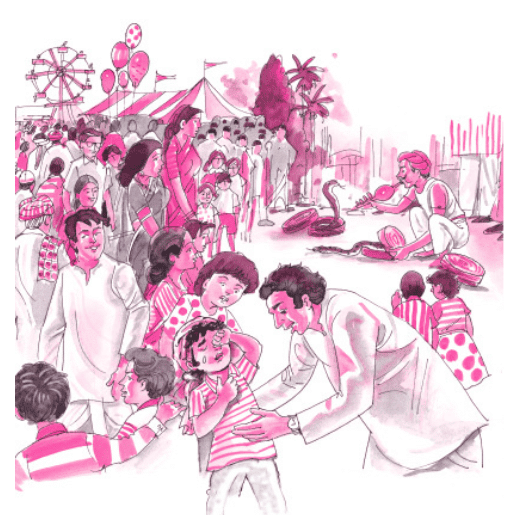NCERT Solutions for Class 9 English Moments Chapter 1 - The Lost Child
Page No.6
Think About It
Q1: What are the things the child sees on his way to the fair? Why does he lag behind?
Ans: The child sees many fascinating things on his way to the fair. He sees toys, a flowering mustard field, dragonflies, insects, and worms. He also sees a sweetmeat seller, a flower-seller, balloons, a snake-charmer, and a roundabout. He gets attracted towards all these things. So, he lags behind.
 The Lost Child
The Lost Child
Q2: In the fair, he wants many things. What are they? Why does he move on without waiting for an answer?
Ans: At the fair, the child desires a burfi from the sweetmeat seller, a garland of gulmohur flowers, colourful balloons, and a ride on the roundabout. He moves on without waiting for an answer because he understands that his parents would likely refuse his requests, thinking they are unnecessary or believing he is too old for such things.
Q3: When does he realise that he has lost his way? How have his anxiety and insecurity been described?
Ans: The child sees a roundabout at the fair and gets attracted to it. He wants to have a ride on it. He asks his parents for permission to enjoy it. Having no response on the part of his parents, he realises that he has lost his way. He starts crying bitterly at once and runs here and there in search of them.
Q4: Why does the lost child lose interest in the things that he had wanted earlier?
Ans: The lost child no longer cares about the things he wanted earlier because he got separated from his parents at the fair. Fear takes over, and he becomes anxious and frightened. All he wants now is to be with his parents, as he feels scared and insecure without them.
Q5: What do you think happens in the end? Does the child find his parents?
Ans: Yes, I believe the child is finally reunited with his parents. The kind man likely did everything he could to help find them, and the parents must have done all they could to search for their child.
Talk About It
Q1: How to ensure not to get lost?
Ans: To avoid getting lost, children should stay close to their parents in crowded areas. Parents should always keep a close watch on their children. It's also helpful for parents to teach children how to recognise landmarks and what to do if they become lost. This knowledge can help them feel more secure and find their way back.
|
180 videos|980 docs|124 tests
|
FAQs on NCERT Solutions for Class 9 English Moments Chapter 1 - The Lost Child
| 1. What is the central theme of "The Lost Child"? |  |
| 2. How does the child’s journey in "The Lost Child" reflect his emotions? |  |
| 3. What role do the parents play in the story? |  |
| 4. How does the author use imagery to enhance the story? |  |
| 5. What lesson can readers learn from "The Lost Child"? |  |

















